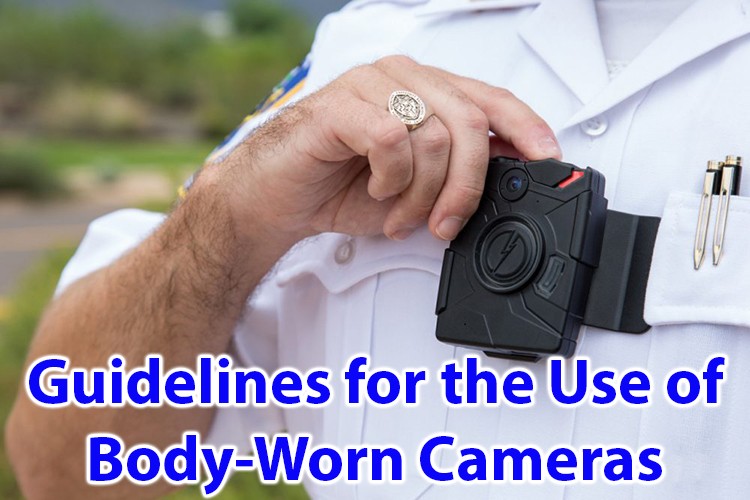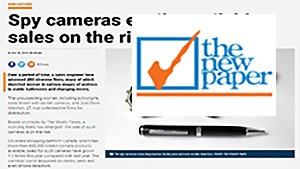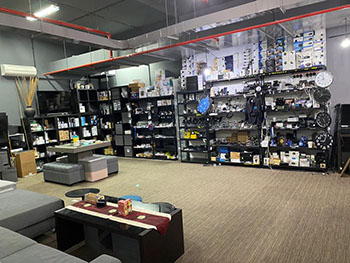Guidelines for the Use of Body-Worn Cameras
Introduction:
This research aims to identify guidelines for the Use of Body-worn Cameras in Law Enforcement Agencies. It is meant to support Law Enforcement Agencies in building up procedures and policies ruling the use of Body-worn cameras. This guideline document relates to the plain use of Body-worn cameras that are used because of the public and with the understanding that the public has been notified of their deployment.
Despite requirements under personal information protection decrees, the use of Body-worn cameras can associate other compulsions of which Law Enforcement Agencies need to be aware.
For instance, Body-worn cameras can record video images, sound and discussions with a high degree of lucidity. Thus, there may be extra concerns raised if the use of Body-worn Cameras in any given context intrudes on the public’s reasonable expectation of privacy or constitutes an interception of private communications, including in places reachable to members of the public. Law Enforcement Agencies also need to be heedful of additional legal implications whenever images and sound are recorded in private spaces, such as inside people’s homes or vehicles.
Body Worn Cameras and privacy:
Body-Worn Cameras are recording devices devised to be worn on a law enforcement officer’s uniform, which can include helmet or glasses. They furnish an audio-visual record of events from an officer’s point of view as officers go about their daily duties. The high-resolution digital images permit for an obvious view of individuals and are suited to running video analytics software, such as facial recognition. Microphones are receptive enough to record not only the sounds related to the situation being targeted but also an ambient sound that could include the conversations of onlookers.
Body-Worn Cameras technology characterizes a major increase in sophistication from the early days of fixed cameras when CCTV systems were being broadly adopted and could only record images and not sound. At that time, several Canadian privacy omission offices issued video observation guidelines for the public sector, which are starting at the end of this document. While the basic privacy principles around video observation remain similar, the environment is now much more composite. As observation technologies develop, ever-larger amounts of personal information (both video and audio) are being gathered in increasingly varied conditions (both static and mobile) with the latent of being linked with yet other private information (e.g. facial recognition, metadata). It is explicable that LEAs would want to deem using new technologies to aid them in executing their duties. At the same time, however, BWC technology poses serious insinuations for individuals’ right to privacy. We believe that addressing privacy deliberations from the onset can allow a suitable balance to be attained between the needs of law enforcement and the privacy rights of individuals.
Effectiveness:
Our Body Worn Cameras are going to be an effectual solution to the operational requirements that have been identified? LEAs should be attentive to the restrictions of technology. Characteristics of events may happen out of camera range, sound recordings may be incomplete owing to the range of background racket, or human error may compromise the usefulness of recordings and reduce their effectiveness. If recordings are meant to be used as proof in court actions, LEAs should deem the requirements identified by Courts for accepting recordings as proof as well as the proof collection and preservation measures advised to make sure those necessities are satisfied.
Proportionality:
Without suspicion, the use of BWCs will result in a loss of privacy because recording individuals’ conversations and actions are innately privacy insidious. As such, any privacy interruption must be minimized to the level possible and counteract by major and negotiable benefits. With new technology, it may be difficult to forecast the full range of positive and negative consequences on day-to-day enforcement and the community being served. Undertaking a pilot project is much recommended as a realistic way of assessing the privacy impacts of Body Worn Cameras concerning their benefits, before deciding whether or not to arrange them, how large, and in what circumstances.
Alternatives:
An ultimate deliberation is whether a less privacy-invasive measure would attain the same objectives. While there may be a business case for a Body-Worn Camera program, unusual measures should be considered to perceive whether they can sufficiently address operational requirements with a less unfavorable collision on privacy. The least privacy enveloping measure is the preferred choice.
Privacy Impact Assessments:
As an extremely recommended best performance, a Privacy Impact Assessment (PIA) should be completed previous to the use of Body Worn Cameras to assist recognize the possible privacy risks of the Body-Worn Camera program. A PIA can be precious in helping LEAs get rid of those risks or decrease them to a suitable level. For instance, there may be extra considerations, such as framework and cultural sensitivities that should be considered in deciding whether to use BWCs in exacting situations. A PIA should comprise a plan for consulting and attractive with the community where BWCs are to be deployed.
Law Enforcement Agencies can also look for the help of privacy experts before implementing a Body-Worn Cameras program. Privacy experts can cram the proposed use of Body-Work Cameras in the community to make sure that any compilation and use of personal information is done to support obligations under privacy legislation.
Secondary Uses:
Employee privacy should also be taken into consideration. Body-Worn Cameras can take law enforcement officers’ data which is guarded under most public sector privacy laws. Potential areas of unease include using Body-Worn Camera recordings to support employee performance assessments. Staff may also have privacy rights under other laws and collective agreements that may influence a BWC program.
If the use of recordings is considered for any functions that are supplementary to the main Body-Worn Camera program purposes, for example, performance evaluation, officer training, or research, these secondary purposes need to be reviewed to make sure compliance with appropriate legislation, and employees need to be well informed of them. As well, criteria should be set up to boundary the privacy impact, such as smudging of faces and any identifying characters and excluding recordings with sensitive content.
Governance and Accountability:
- The foundation for deploying BWCs, including operational needs and program purposes.
- The lawmaking authorities for gathering personal information under the program.
- Roles and responsibilities of staff concerning Body-Worn Cameras and their recordings.
- Criteria for context-specific incessant recording and turning BWCs on and off, as appropriate.
- Provision for a prepared guide and training for employees to make sure that officers know the privacy insinuations of Body-Worn Cameras and be aware of their responsibilities under these policies and procedures.
- Privacy guards for employees whose personal information is captured by Body-Worn Cameras.
- The allotment of liability for ensuring that Body-Worn Camera policies and procedures are followed, with on the whole accountability resting with the head of the organization.
- The cost of not respecting the policies and procedures.
- Right of Individual of recourse. Individuals should be notified that they have a right to complain to the Law Enforcement Agencies’ privacy mistake body concerning the management of a recording holding personal information to decide whether a contravene of privacy law has taken place.
- The obligation that any agreements between Law Enforcement Agencies and third-party service providers identify that recordings linger in the control of Law Enforcement Agencies and are subject to suitable privacy laws.
- A stipulation for normal internal audits of the Body-Worn Camera program to address compliance with the procedures, policy, and applicable privacy laws. The audit should comprise a review of whether Body-Worn Camera watch remains justified in light of the stated purposes of the program.
- In jurisdictions with a PIA policy, a provision for PIAs whenever there are significant alterations to the program.
- The name and contact information of an individual who can reply to questions from the public.
Use and Disclosure of Recordings:
- The situations under which recordings can be watched. Watching should only happen on a need-to-know foundation. If there is no doubt of unlawful action having occurred and no allegations of misbehavior, recordings should not be viewed.
- The purposes for which recordings can be used and any limiting circumstances or criteria, for example, omitting sensitive content from recordings being used for training purposes.
- Defined bounds on the use of video and audio analytics.
- The circumstances under which recordings can be revealed to the public if any, and limitations for any such exposure. For instance, faces and identifying marks of third parties should be blurred and voices twisted wherever possible.
- The circumstances under which recordings can be disclosed externally the organization, such as, to other government agencies in a lively investigation, or legal envoys as part of the court detection development.
To sum up, Body-worn cameras are highly beneficial along with all its demerits it not only records the speech and actions of an individual but also individuals’ associations with others within the range of recording, including family members, onlookers, friends, suspects, and victims. The recording of individuals through the use of Body-worn cameras lifts an important risk to individual privacy, and Law Enforcement Agencies must be dedicated to only deploying Body-Worn Cameras to level and in a way that protects and respects the general public and employees’ right to personal privacy.









